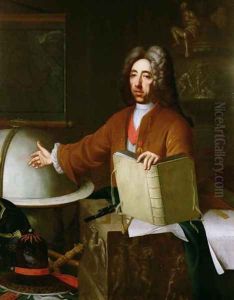Jacques or Jakobus van Schuppen Paintings
Jacques van Schuppen, also known as Jakobus van Schuppen, was a painter of Flemish origin who spent a significant part of his career in France. Born on May 29, 1670, in Fontainebleau, France, he was the son of the Flemish painter-engraver Pieter van Schuppen, who was originally from Antwerp, and Elisabeth de Mesmaker. Jacques was born into an artistic environment, which naturally influenced his career choice as he followed in his father's footsteps.
The young van Schuppen began his artistic training under his father's guidance. He later continued his studies under the prominent French painter Hyacinthe Rigaud, who was well-known for his portrait paintings, particularly those of Louis XIV. Under Rigaud's tutelage, van Schuppen honed his skills in portraiture, a genre that would later become his specialty.
Although van Schuppen was of Flemish descent, his career flourished in France, where he became a court painter. In 1704, he gained membership in the Académie Royale de Peinture et de Sculpture, an institution that played a major role in the artistic life of France at the time. His acceptance into the academy was a testament to his skill and the recognition he had garnered as a portraitist.
Throughout his career, van Schuppen painted portraits of various members of the nobility and other prominent figures of his time. His style was characterized by a certain elegance and a focus on the fine details of his subjects' attire and surroundings, which was typical of the grand portraiture of the era. He was adept at capturing the likeness and the dignified bearing of the individuals he painted.
Van Schuppen also contributed to the spread of the French artistic style across Europe, particularly through his engravings, which were widely distributed. His works are notable for their technical proficiency and their role in disseminating the grand manner of portraiture that was prevalent in France during the late 17th and early 18th centuries.
Jacques van Schuppen passed away on January 13, 1751, in Paris. While he may not be as well-remembered today as some of his contemporaries, his contributions to the art of portraiture during the reign of Louis XIV and beyond were significant. His works remain a testament to the cross-cultural artistic exchanges between France and the Low Countries during the Baroque period.
